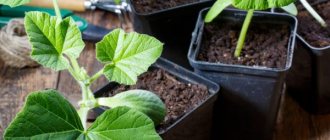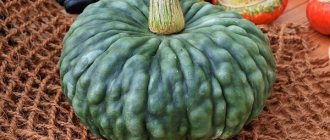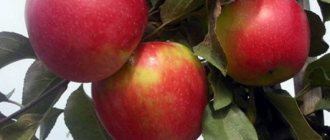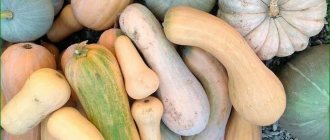The “Volga Gray” pumpkin captivates gardeners with its large, tasty fruits and excellent keeping quality. We will learn how to plant and grow this old, time-tested variety, and how to achieve high yields.
Volzhskaya gray pumpkin gives a high yield
Volga gray pumpkin stores well
Volzhskaya gray pumpkin
Description and characteristics of the “Grey Volga pumpkin”
“Volzhskaya gray 92” is a mid-season and large-fruited variety, bred in 1940. Regions recommended for cultivation are the North Caucasus, the Lower Volga region, and some areas of the Urals.
The plant is of medium size. There is a thick central shoot from which thinner side shoots branch. The foliage is moderate. Leaves are prone to drying out. With good watering, the foliage is raised and covers the pumpkins, protecting them from the scorching sun.
The flowers of this variety are medium-sized, pale yellow, slightly pubescent on the outside.
Description of fruits
It is easy to recognize the “Volga gray” pumpkin by the gray color of the pumpkins. Even in a state of rich ripeness, the rind does not turn yellow.
Description of fruits:
- Form. The fruits of “Volga Gray” are round, slightly flattened at the top and bottom.
- Crust. Smooth, dense, segmented. Without picture.
- Color. The ripe fruit has a light gray rind. Sometimes with a greenish tint.
- Pulp. The inside of the fruit is cream or yellow; when fully ripe, the flesh turns orange. Density and sweetness are medium. The thickness of the pulp layer is 4-5 cm.
- Seeds. Semi-oval, pronounced pumpkin taste. They are consumed raw and fried.
The average weight of pumpkins is 10 kg. Some specimens reach a weight of 20 kg. 2-3 fruits grow on one bush.
Main characteristics
"Volga gray" pumpkin is sun-loving, but its leaves are afraid of sunburn. It can grow in shaded areas if it receives stable, indirect sunlight.
Main characteristics of the “Volga gray” pumpkin:
| Characteristics/parameters | Description/meaning |
| Ripening time | 3.5-4 months (mid-season) |
| Cold resistance | Withstands temperatures down to +10 °C |
| Drought resistance | High |
| Pest resistance | Average |
| Productivity | 15 kg per 1 sq. m |
| Purpose | Universal |
| Transportability | good |
| Keeping quality | Excellent |
Characteristics of the variety
The Volga gray (or its variety - 92) is a large-fruited pumpkin; with good care, it weighs about 20 kg. Average weight 10-12 kg.
The fruits are round in shape, slightly flattened at the bottom and in the area of the stalk. The skin is thick, smooth, and some specimens develop slight ribbing. Thanks to these qualities, the description of this crop also includes good shelf life and transportation. They are stored in the garden for a long time - they do not rot or mold.
Under the skin there is creamy or orange-yellow pulp, in the middle of which there are not too large seeds - they are also nutritious and beneficial for the body.
Advantages and disadvantages of the variety
Advantages of “Volga gray” pumpkin:
- Able to tolerate long droughts, provided that the ovaries have already formed.
- Consistently high yield.
- Large fruits.
- High taste qualities.
- The pulp of the fruit contains a lot of beta-carotene, potassium and iron.
- Thanks to the dense crust, it has good shelf life. During storage, the fruits do not lose color and taste, and do not rot.
Flaws:
- Increased demands on fertilizing. To get many large fruits, the crop needs regular feeding with mineral and organic fertilizers.
- Low cold resistance. The variety is more suitable for the southern regions.
Reviews
Experienced gardeners rate the gray variety positively. The main advantage of the vegetable is its taste. With minimal costs, you can stock up on crops for six months. Pumpkin is well stored and easily transported over long distances.
Gardeners advise growing the variety in regions with a temperate climate. A large amount of sunlight and moderately humidified air will allow you to get a good harvest. The pumpkin variety has few disadvantages, which is why it is so popular in Russia.
Features of planting and growing
This variety of pumpkin is grown by direct sowing of seeds in the ground or seedlings. The future harvest is influenced by many factors - the quality of seeds and seedlings, planting dates, soil, site characteristics and much more.
About deadlines
The timing of planting pumpkins depends on two factors:
- The growing region, its climate and current weather conditions.
- Growing methods - planting times for seeds and seedlings are different.
In the southern regions, seeds are sown in open ground in mid-May, in cooler regions - in early summer.
When choosing the timing of landing, they are guided by the weather. Pumpkin is planted when the soil warms up to +14-+17 °C. If you plant seeds or seedlings in colder soil, they will begin to rot.
The timing of sowing seeds for seedlings is calculated taking into account the rule - seedlings transplanted into the ground should be about 1 month old.
Choosing a landing site
Site requirements:
- Well lit place. Slight shading possible.
- Deep groundwater. You cannot plant pumpkins in lowlands - the fruits will not be sweet and watery.
- The soils are loamy and sandy loam, loose and well fertilized with organic matter.
- Neutral soil acidity level.
- No tall plants should grow nearby.
- The best soils are loams and sandy loams. Clay soils are not suitable for growing pumpkins - the fruits develop thin and hard pulp.
- Optimal predecessors are onions, green manure, cabbage, legumes, radishes. You cannot plant pumpkin after potatoes, sunflowers, zucchini, squash, cucumbers, melons and watermelons.
The optimal temperature for the growth and development of Volga gray pumpkin is +25 °C.
Site preparation
Soil preparation begins in autumn:
- The area is dug up, adding compost or rotted manure. The norm of manure is 1 bucket per 1 sq. m.
- Additionally, mineral fertilizers are applied - 50 g of potassium salt and 80 g of phosphorus per 1 sq. m. m.
- In the spring, before planting, the area is dug up again.
Many gardeners plant pumpkins directly on compost heaps, then fertilizing will not be needed throughout the entire growing season.
Seed preparation
Pumpkin seeds are prepared for planting as follows:
- Soak in a weak solution of potassium permanganate - 60 minutes. The procedure is aimed at disinfecting the seeds.
- Wrap in damp cloth to hatch. From time to time, moisten the fabric with water - for example, using a spray bottle. Sprouts appear after a few days.
Gardeners have another method of preparing seeds:
- Keep the seeds in the oven at a temperature of +40 °C.
- Keep for 12 hours in gauze soaked in ash solution.
Sowing seeds
Planting pumpkin seeds in open ground:
- Prepare the wells in advance. The distance between adjacent holes is 60-80 cm, between rows - 1.5-2 m. The pumpkin needs space, so you should not reduce the gaps.
- Pour 1-2 liters of warm water into the wells, heated to +50 °C.
- Wait for the water to be absorbed and bury the seeds - pointy ends down. Place 2-3 seeds in one hole. When shoots appear, leave the strongest sprout and pinch the rest.
- Sprinkle the seeds with soil - a layer of 6-7 cm. If the soils are heavy, 3-4 cm is enough. Mulch the crops with peat or compost.
- Cover crops with film if there is a risk of frost. Thanks to the greenhouse effect, seedlings will appear faster.
Seedling care
It can take up to 10 days for seeds to germinate. Another 30 days will be needed to grow seedlings. Count 40 days from the intended planting date, and soak the seeds on this day.
Procedure for growing pumpkin seedlings:
- Prepare planting containers. The best option is peat cups, since pumpkin does not like transplants, and this “container” can be buried in the ground along with the roots of the seedlings.
- Plant the germinated seeds in peat containers. If they are not available, use glasses filled with a mixture of turf soil, humus, peat and mullein (1: 3: 5: 1). Planting depth is 4-6 cm. Before sowing, do not forget to water the soil well.
- Cover the crops with film. Ventilate your crops regularly. The optimal daytime temperature is +25 °C, night temperature is +15-+18 °C.
- When shoots appear, remove the film. To prevent the seedlings from stretching, place them in a well-lit place. First, reduce the daily temperature to +15-+18 °C, and after 5 days raise it again.
- Water the seedlings as the soil dries out.
- A week after emergence, feed the seedlings - 15 g of nitrophoska per 10 liters of water, or mullein (1:10 solution).
- When the seedlings reach 15-20 cm, you can plant them in open ground.
Transplanting seedlings
As soon as the pumpkin seedlings reach condition and favorable conditions are created, they are transplanted into open ground:
Procedure for transplanting seedlings:
- In a pre-prepared area, dig holes according to the same pattern as when planting seeds - 60-80x150-200 cm.
- If the seedlings are grown in peat pots, destroy the dense outer walls. If the seedlings grew in a substrate - in glasses or containers, water them in advance to make it easier to transfer them into the hole.
- Plant seedlings in cloudy weather or in the evening. Try to move it along with the soil so as not to damage the roots.
- Water the seedlings generously and shade them for the first time.
- Mulch the soil and create a border around each seedling to prevent water from spilling out when watering.
Top 3 modern pumpkin dishes
Unfortunately, storing pumpkin for a long time is very difficult. Therefore, it must be used during the first months after harvest. The Gray Volzhskaya variety is often used as a feed crop for livestock or poultry. But with the same success, this pumpkin can be used in cooking. You shouldn’t limit yourself to standard porridges, because today there are so many new and original recipes using this vegetable.
Pumpkin is great for preparations, salads, and desserts
Salad with pumpkin and bacon
Ingredients:
- pumpkin - 200 g;
- bacon - 150 g;
- Iceberg salad - 200 g;
- quail eggs - 3 pcs.;
- cherry tomatoes - 3 pcs.;
- sesame and herbs;
- olive oil.
Pumpkin and bacon should be cut into as thin slices as possible. Coat the pumpkin with oil, sprinkle with herbs and place in the oven for 10 minutes, and fry the bacon in a dry frying pan. Tear the salad with your hands, cut the boiled eggs and tomatoes into 4 parts. Place all ingredients beautifully on a plate, sprinkle with sesame seeds and lightly drizzle with oil.
Spicy pumpkin with veal
Ingredients:
- pumpkin - 1 kg;
- veal - 1 kg;
- onion - 250 g;
- prunes - 100 g;
- bell pepper - 100 g;
- soy sauce;
- olive oil;
- ground black pepper.
This dish is very easy to prepare in a slow cooker. All ingredients need to be peeled, washed and cut into cubes. Pour oil into the multicooker bowl and lay out the food in the following layers: meat, prunes, pumpkin, onions, peppers. Pour soy sauce on top and add ground pepper. Set the multicooker to “Stew” mode for 90 minutes.
You can freeze pumpkin for the winter
Pumpkin soufflé
Ingredients:
- pumpkin - 400 g;
- egg - 1 pc.;
- orange - 1 pc.;
- ginger;
- milk - 150 g;
- honey - 2 tsp.
Cut the pumpkin and boil for 20 minutes. Grind the orange zest and ginger. Squeeze the juice from the orange. Separate the white from the yolk. Place the yolk, pumpkin, orange juice and zest, ginger pulp, milk and honey in a blender bowl, beat everything. Separately, beat the egg whites with a mixer into a thick foam. Mix everything and bake in the oven over low heat.
Pumpkin does not require much labor to grow. But the benefits of this vegetable can hardly be overestimated. This is a real orange doctor who treats diseases of the kidneys, liver, skin, and eyes. Pumpkin is recommended for use by patients with tuberculosis, hypertension, and obesity. This fruit makes it easier to endure pregnancy and slow down the aging process of the body. And it's just very tasty.
Rules for caring for “Grey Volga pumpkin”
It is not enough to plant a pumpkin correctly, you also need to provide it with decent care - the size, taste and number of fruits will depend on this.
Volumes and frequency of watering
The yield - its quantity, as well as the size and taste of the pumpkins - depends on the regularity and volume of watering the pumpkin.
Watering rules:
- Pumpkin evaporates a lot of water through its large leaves, so it needs abundant and regular watering.
- Pumpkin is watered especially generously during flowering and fruit formation.
- For irrigation, use warm, settled water, no cooler than +22 °C. Water can be heated directly in the sun - in large containers.
- Do not water the pumpkin with cold water. This is especially dangerous in hot weather - plants can die.
- At the beginning of the growing season, the watering rate is 2 liters per bush, subsequently the rate is increased to 10 liters.
- At the beginning of the growing season, the frequency of watering is greater. Seedlings are watered every 3-4 days. Subsequently - as the soil dries out.
- When pumpkins bloom, first loosen the soil, remove weeds and only then water - during this period the plant needs more water.
Increased moisture consumption is observed during fruit formation.
Pumpkin feeding
“Volga gray” pumpkin is fed three times:
- First feeding. When 3-5 leaves appear, mullein is added - 1/2 liter of liquid fertilizer is dissolved in a bucket of water. Water at the root. The norm is 10 liters per 5 bushes.
- Second feeding. During the period of growth of lashes. Mullein is used, but 1 tbsp is added to each bucket. l. nitrophoska.
- Third feeding. Carry out during fruit formation. Add a glass of ash and potassium sulfate - 2 tbsp to the mullein solution. l.
Loosening the soil and weeding
The purpose of loosening is to increase the moisture and air permeability of the soil. Loosening features:
- During loosening, weeds are removed along the way - they choke the crops and take away moisture and nutrients from the pumpkin.
- Loosen the soil until the root collars are clearly visible. When pumpkin leaves become large, they themselves suppress the growth of weeds, and weeding becomes unnecessary.
- The soil must be loosened after watering and rain.
- The first time the soil is loosened 15 cm deep, then the loosening depth is gradually reduced. After a month, the soil is loosened no more than 8-9 cm so as not to damage the roots of the plants.
- To prevent moisture evaporation and weed growth, the soil is mulched with peat or humus.
Bush formation
To get large fruits, “Volga gray” requires the formation of a bush:
- At the beginning of growth, in order to increase bushiness, pinch the apical shoot when 2-3 pairs of leaves appear.
- A plant is formed with 1-2 lashes, each of which has several flowers. To get larger pumpkins, form the plant into one vine.
- Excess inflorescences are removed, leaving a few flowers in the trunk area.
- On the main stem, on each side, after 4 leaves, one shoot is left, the rest are removed.
- The tops of the vines are positioned so that they are in the sun, otherwise the fruits will be small.
Harvest and storage
Rules for collecting and storing pumpkins:
- Harvest the fruits before frost begins.
- The maturity of the fruit is determined by the stalk - it should darken and dry out.
- After harvesting, the fruits are dried in the sun or in a dry room.
- Pumpkins are stored in the basement, cellar, or on a glassed-in balcony.
- The fruits of this variety can be stored for a whole year. To do this, they are placed in a well-ventilated room with a temperature of +6 °C and a humidity of 70%. Pumpkins are placed on shelves covered with dry straw.
- Fruits can be stored in an apartment for up to 5 months.
- Pumpkin can be stored frozen. It is peeled, cut into portions, placed in a hermetically sealed container and placed in the freezer.
Harvest and storage
It is better to harvest gray pumpkin before the first autumn frosts. The harvest of this variety can be stored in different ways:
- the fruits are transferred to a cool and dry room - a basement, cellar or to a glazed balcony;
- some people store pumpkins in the refrigerator compartment in the vegetable section;
- The vegetable lasts the longest in the freezer - it is peeled, cut into portions, placed in a container or plastic bag and placed in the freezer.
Diseases and pests
The variety was bred a long time ago, so it is not resistant to many diseases and pests. The greatest danger to it is represented by fungal diseases.
The most common diseases and pests of the “Volzhskaya gray” pumpkin variety:
| Diseases/pests | Signs of defeat | How to fight? |
| Bacteriosis | There are brown spots on the leaves that dry out over time. Holes appear in place of the spots. | Remove and destroy the affected shoots. Spray for prevention with a 1% solution of copper sulfate. |
| White rot | There is a white coating on the leaves and fruits. They soften and rot. | The affected parts are removed and burned. The cut areas are sprinkled with charcoal. |
| Powdery mildew | There is a grainy white coating on the leaves. Gradually the plant dries out and dies. | Cut off the affected leaves. Spray with colloidal sulfur - take 20 g per 10 liters. |
| Aphid | Affects foliage and inflorescences. Can destroy the entire crop. | Spray with a 10% solution of karbofos. |
| Spider mite | The leaves are covered with spots, a whitish web weaves around the back of the leaves. | Weeds are removed in a timely manner and crop rotation is observed. For spraying, use a 20% solution of chlorine etalon. Or prepare a decoction of onion peels - take 300 g for 10 liters. |
Features of further care
In order for plants to produce the maximum possible yield, they need to create comfortable conditions for growth and fruit formation.
Watering and fertilizing
Since the root system of the Volga gray pumpkin goes 3–4 m deep, this crop requires abundant but infrequent watering, the frequency of which is adjusted as the soil dries out. Soft rainwater is best suited for this purpose. If irrigation is planned to be carried out with tap or spring/well water, then it will have to be preheated in tanks.
Did you know? Different varieties of pumpkin are divided into edible, decorative and industrial. Containers, vessels and even musical instruments are made from dense, overripe fruits with a hard peel. In some African countries, there is a practice of producing motorcycle helmets from certain specially processed varieties of pumpkins.
Watering the pumpkin must be carried out at the root level, and apply water not under the root collar, but in a shallow groove around the bush, so that the root system is not washed out of the soil. For watering, you should choose a period of morning or evening coolness - this way you will avoid sunburn on the foliage and fruits. It is mandatory to loosen the soil before watering to a depth of about 10 cm. As for fertilizing, it should be carried out regularly so that the Volga gray pumpkin does not deplete the soil.
Depending on the fertility of the substrate, the frequency of fertilizer application must be adjusted. If the pumpkin grows in soil rich in organic matter, then it must be fed three times from the moment the seedlings are planted. Nutrient-poor soils should be enriched every week and a half during the vegetative period of pumpkin growth. The best fertilizer for this crop is potassium; it must be applied even when planting seedlings in the form of wood ash at the rate of 10 g per hole.
Fertilizers for feeding pumpkins are used:
- mineral;
- organic.
Pumpkin needs both types, they must be added in turn to maintain the balance of nutrients. The first feeding should be especially nutritious - a solution of manure (1:10) or litter (1:20) is used for it. For each bush, 0.4–0.5 liters of fertilizer are applied, then the fertilization process is repeated every 1.5 weeks, adding 1 liter after the start of flowering and 1.5 liters after the fruit appears.
Possible difficulties during cultivation
Gray pumpkin is unpretentious, but the following problems may occur when growing the variety:
- The variety does not like damp and cool weather. Under such conditions, the plant is affected by fungal diseases.
- If you do not feed the pumpkin in time, the yield decreases and the size of the fruit decreases. It is important that the vegetable’s nutrition contains all three main elements of fertilizing – nitrogen, potassium and phosphorus.
- The variety is capricious in terms of growing conditions - if there is poor lighting on the site, groundwater is nearby or undesirable predecessors grow, the crop sharply reduces the yield.
How to be guaranteed to get fruits
Sometimes while growing a pumpkin, the ovaries begin to rot. This phenomenon occurs when pollination of female flowers is unsuccessful. There are many reasons why this happens, most often unfavorable weather conditions are to blame. On rainy and cloudy days, insects fly much less. Losing a harvest is always unpleasant, especially if it concerns large-fruited late-ripening varieties.
To prevent such situations, flowers are pollinated artificially. In the first half of the day, when the female flowers bloom, you need to collect the male flowers, remove the petals and attach several anthers to the pistil of the open female plant.
A little trick. In some garden areas, a pumpkin can entangle fences or the walls of a gazebo with its lashes. To avoid the collapse of structures, you can use nets; you just need to attach them to the fence and place the growing fruits there.
Giant pumpkin varieties often suffer from soil dampness and the crop begins to rot. The easiest way to prevent such a nuisance is to install supports on the ground and place a thick sheet of plywood or several boards on top. The main thing is to start taking measures while the fruits are small, otherwise it is very easy to break off the stem of the plant at the moment when the pumpkin is transferred to the flooring.
Secrets to Successfully Growing Pumpkins
Experienced gardeners advise beginners:
- When preparing seeds for planting, discard moldy and mechanically damaged specimens.
- Do not plant pumpkins in waterlogged or acidic soils.
- Enrich the soil with humus and add peat or sand to loosen it.
- Do not be lazy to remove weeds and plant debris - this will prevent many diseases.
Choosing a landing site
For planting, choose sunny or slightly shaded places. In autumn or spring, choose beds located on a flat, sunny area; a slight slope is allowed. During digging, fertilizers are applied, both organic and mineral. The prepared seed material is placed in the holes to a depth of no more than 10 cm; by the time of planting, the soil should warm up to +15 degrees.
It is recommended to plant pumpkins away from tall, upright crops that may begin to use their new neighbors as supports. The distance between the holes is 0.6 - 0.8 meters, a couple of seeds are placed in each. After the shoots appear, it is necessary to pick and remove the weak shoots, leaving the most powerful ones.
Seedlings are planted using a similar method; they can be transferred to open ground after 30 days from the moment the plants appear.
Planting germinated seeds
Reviews of the “Grey Volga” pumpkin
★★★★★
Vasily, 40 years old, amateur gardener, Novocherkassk. I have been growing pumpkins for many years, “Volzhskaya gray” is one of my favorite varieties.
It stores very well, so you will have enough pumpkin until summer. Of course, it is not as beautiful as the orange varieties, but I don’t chase beauty. ★★★★★
Nina, 50 years old, summer resident of Novy Oskol. I really like the “Volzhskaya Gray” variety – it grows well and never leaves without a harvest.
It was possible to grow pumpkins up to 15 kg. The pulp is sweet, suitable for any dishes, and goes well with various foods. Hide
Add your review
Growing a “Volga gray” pumpkin is not difficult, the main thing is to water it on time, feed it, pinch the bushes correctly and do not forget about disease prevention. The variety is so good that, despite its long history and many new competitors, it remains one of the most popular among gardeners.
0
0
Copy link
Botanical description
This crop is mid-season and has large fruits weighing about ten kilograms. On average, approximately four months pass from seedling germination to fruit formation at the stage of removable maturity. The high shelf life of the Volga pumpkin allows you to collect and store its harvest in large quantities, as well as transport it over long distances without losing its presentation.
Young shoots of pumpkins are formed from seeds or seedlings, forming a medium-sized bush with side vines up to four meters long. The parts of the lashes that are closer to the stalk are distinguished by a dark green tint with longitudinal stripes of almost black color. The leaf blades are dense, rich green in color with moderate pubescence; As the fruits ripen, they lose their rigidity, and the division of the leaves into segments becomes noticeable.
The fruits have the following characteristics:
- have a round shape, slightly flattened at the poles;
- the skin is smooth, uniform and elastic, without visible spots, stripes, ribs, light gray in color;
- segmentation appears when the fruit ripens - the larger it is, the better the segments are expressed;
- the pulp of a ripe vegetable has a rich orange tint, which may darken during storage;
- the thickness of the pulp layer reaches six centimeters;
- medium-sized seeds (up to 3 cm), can be used for food.











